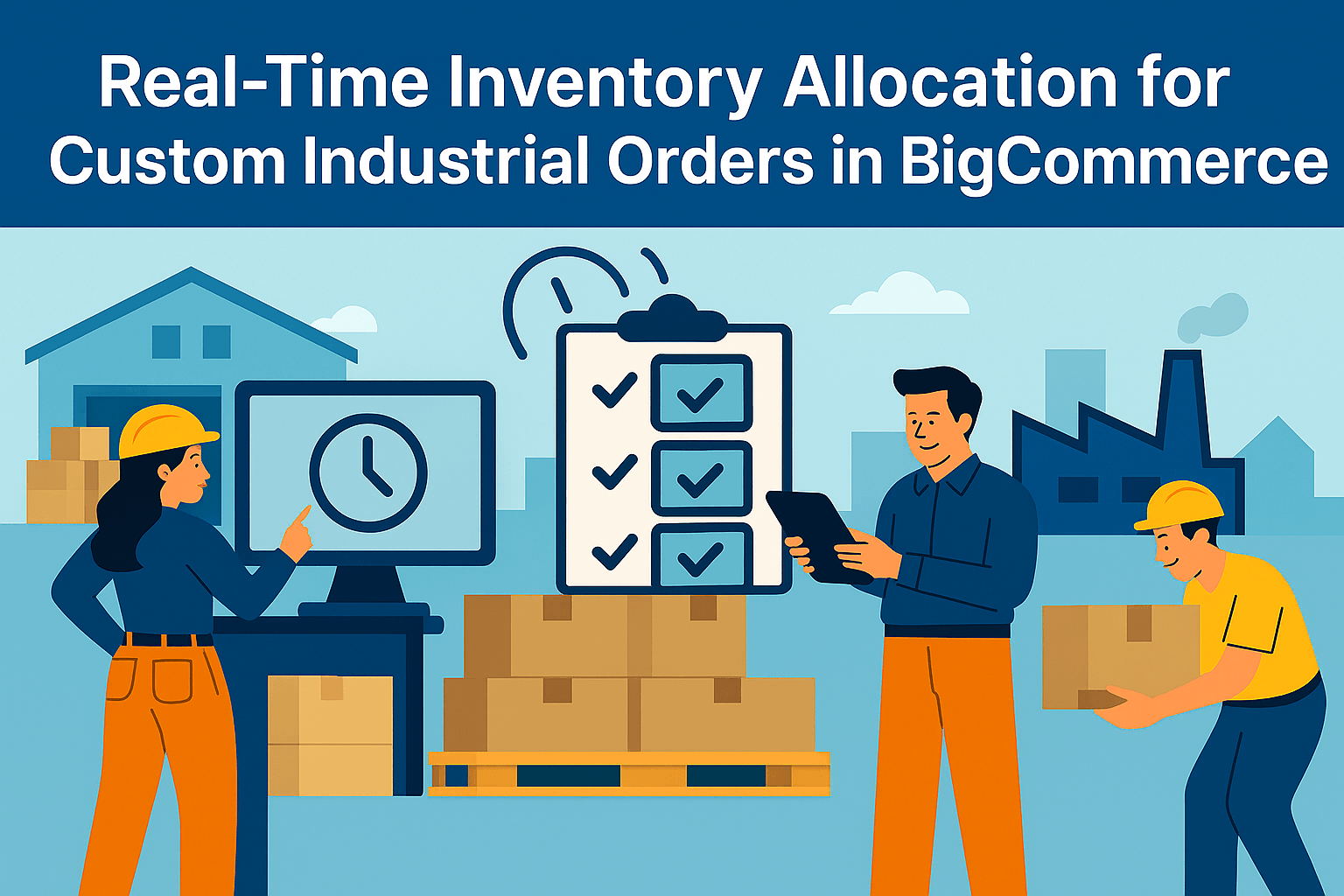Why Trust Lives or Dies on Inventory Visibility
In custom manufacturing, the hardest part of the sale isn’t winning the contract—it’s keeping the customer confident after they sign. Buyers don’t just want equipment delivered; they want certainty that what they ordered is moving through the pipeline exactly the way it should.
Here’s the problem: most manufacturers can’t give that certainty without a phone call. A procurement officer places an order, and within a week, they’re on the phone with a rep asking, “Are my materials allocated yet? When will this actually ship?” That one question exposes the weakness in most inventory systems: the truth about allocation and production lives in the ERP or MRP, but the buyer never sees it.
Standard live stock e-commerce logic makes the gap worse. A storefront that simply shows “in stock” or “out of stock” means nothing in a made-to-order environment. Steel plates might be sitting in the warehouse stock, but if they’ve already been earmarked for another job, they’re not really available. A gearbox component might look “ready,” but if machining hasn’t been scheduled, the promised lead time is fiction.
Buyers know this, which is why they don’t trust the numbers on the storefront. They trust their rep’s Excel update. They trust the person they can call who knows how to pull data from the ERP. That dependency might feel manageable, but it scales poorly. It eats up sales bandwidth, creates miscommunications, and puts relationships at risk when delays surface too late.
Trust in manufacturing lives or dies in that gap between what your ERP knows and what your industrial buyer sees. BigCommerce alone can’t solve it, but when integrated with ERP/MRP, it can become the window that finally closes the trust gap. Buyers stop calling for updates because the information they used to chase is sitting in their portal: materials allocated, production scheduled, and lead times accurate.
That shift, from hidden systems and manual updates to transparent, real-time allocation, is what turns a storefront from a catalog into a contract-protection tool.
The Complexity of Custom Industrial Orders
If you sell consumer goods, inventory is simple: a shirt is either on the shelf or it isn’t. In industrial manufacturing, it’s never that black and white.
Take a custom machine order. On paper, you might have the raw steel, bearings, and motors in the warehouse. But until those materials are formally allocated to a job, they’re just potential—not a promise. A single late allocation can derail a build. The steel might already be spoken for by another order. The motors might be tied up in a project with a delivery penalty clause. From a buyer’s perspective, “in stock” is meaningless if the order isn’t secured against those parts.
And inventory is only half the battle. Production sequencing is where things really get complicated. Let’s say you manufacture industrial pumps. The pump housing can’t be machined until the foundry delivers castings. The assembly floor can’t start until machining is complete. The test bench can’t run until assembly finishes. Each stage depends on the last—and any disruption pushes the delivery date. To the buyer, all they see is silence until suddenly the date slips.
Contracts make this even higher stakes. Many industrial agreements include late penalties. If an order misses delivery by even a few days, you’re not just facing frustration—you’re facing financial hits and legal disputes. That’s why procurement officers obsess over visibility. They don’t just want to know if materials exist. They want to know if their specific order is locked in, scheduled, and moving.
This complexity is exactly where standard inventory systems fail. They can say “available” or “backordered,” but they can’t tell a buyer the truth: Has my order been allocated? Is production scheduled? When will this really be ready? That’s the level of transparency manufacturers have to provide if they want trust to hold.
Where Standard Inventory Systems Fail
Most inventory systems were never designed for the messiness of made-to-order manufacturing. They work fine if you’re selling boxed products off a shelf. But when your business runs on contracts, critical components, and production schedules, those same systems collapse under the weight of reality.
The first failure is the illusion of simplicity. A typical ecommerce platform gives buyers two signals: “in stock” or “out of stock.” On a consumer site, that works. In custom manufacturing, it’s laughably inadequate. Ten gearboxes might show as “in stock,” but if eight are already reserved for other builds, that’s not really real-time inventory—it’s a liability waiting to explode into a missed delivery.
The second failure is the disconnect between ERP and storefront. The ERP or MRP often holds the truth: which materials are allocated, what capacity is booked, and what timelines are realistic. But buyers never see that. What they get instead is a storefront with vague promises and a sales team stuck as translators, pulling updates from ERP, pasting them into emails, and updating Excel trackers just to keep customers informed.
Then comes the human bottleneck. Procurement officers end up calling reps for updates, reps call operations, operations exports a spreadsheet, and by the time the numbers reach the buyer, they’re already stale. Everyone wastes hours chasing information that should have been visible instantly.
The result is predictable: missed expectations, strained relationships, and sometimes lost contracts. Not because production failed, but because communication failed. The system that knows the truth and the system the buyer sees are speaking different languages—and the gap between them is where trust evaporates.
The Buyer’s Perspective: Why Transparency Matters
Imagine being the person responsible for keeping a plant running smoothly. You’ve placed a custom order worth half a million dollars, tied to a contract with deadlines you can’t miss. On paper, everything looks fine. You got the confirmation email, and the portal shows the order as “processing.” But “processing” tells you nothing. Is the steel actually allocated? Has machining even started? Or is your order still sitting in a queue behind ten others?
So you do what you’ve always had to do: pick up the phone. You call your rep, who calls operations, who pulls a report from the ERP. By the time the update trickles back to you, you’re looking at numbers that may already be out of date. And in the back of your mind, you’re still wondering if the job is really on track—or if you’ll be the one explaining to your boss why the project just slipped three weeks.
That’s the part most suppliers don’t fully grasp. Procurement officers aren’t just buying parts; they’re buying predictability. When the system they’re supposed to rely on gives them vague placeholders, they don’t feel reassured—they feel exposed. Every time they log into a portal that can’t tell them where their order really stands, they start to hedge. They over-order. They double-source. They quietly start checking what competitors can offer.
It’s not the delays that break trust; delays happen in manufacturing. What breaks trust is finding out late or finding out by accident. Buyers don’t want to be surprised. They want to see what you see: if materials are reserved, if production is underway, and if the timeline is still real. That visibility is the difference between a relationship that feels secure and one that feels like a gamble.
BigCommerce as the Front-End to ERP/MRP
Your ERP or MRP already knows the answers buyers are desperate for. It knows which materials have been allocated, what stage production is in, and when the earliest realistic ship date is. The problem is that information lives behind a wall. Buyers never see it. Sales reps translate it through spreadsheets, emails, and late-night phone calls. By the time it reaches the customer, the numbers are stale.
BigCommerce doesn’t replace your ERP—it doesn’t need to. Instead, when connected via APIs or middleware, it becomes the window buyers look through to see ERP and MRP data in near real time. Instead of logging into a storefront that just says “processing,” buyers log into a portal that reflects the actual data flowing through your ERP:
- Materials allocated: yes or no.
- Estimated completion date: March 12, based on production schedules.
- Production stage: machining in progress.
That’s the kind of detail that changes the conversation. Buyers no longer call reps for updates because the answers are already in front of them. Reps no longer scramble to interpret ERP reports because the system speaks for itself. And procurement officers, the ones with careers staked on deadlines, can finally plan with confidence instead of guesswork.
The shift is about taking the information you already trust internally and making it visible to the people who need it most. BigCommerce just happens to be the most effective place to surface it, because it’s already where buyers go to order, track, and manage their accounts.
When you connect the two—ERP as the source of truth, BigCommerce as the front-end—you eliminate the gap that erodes trust. Buyers stop seeing your system as a black box and start seeing it as a partner.
Blueprint for Real-Time Allocation
Most manufacturers already have the information they need. The ERP or MRP system knows which materials are spoken for, which machines are scheduled, and when an order is realistically going to ship. The problem isn’t the data. The problem is that the buyer never sees it. What they see is a portal with vague statuses like “processing.”
So what does a real-time allocation setup actually look like?
It starts with allocation. Imagine a customer has ordered a run of custom pumps. Your ERP marks the raw steel, the seals, and the bearings as reserved against that specific order. At that moment, the ERP knows more than the storefront ever will: those materials are locked in. From the buyer’s perspective, that’s the most important update they could get—not “we have stock in the warehouse,” but “your job has what it needs, and it’s secured.”
Next comes production scheduling. The ERP doesn’t just know materials are there—it often knows when machining will start, when assembly is slotted, and when testing is booked. Depending on the setup, this can be tracked down to the day or through linked MES systems. The frustration comes when buyers never see any of it. All they get is a placeholder until, suddenly, the deadline slips.
A proper integration pushes those updates out of hiding. Instead of sales reps exporting a spreadsheet on Friday and emailing it on Monday, the data moves automatically into BigCommerce. When a procurement officer logs in, the portal doesn’t say “processing.” It says:
- Materials allocated: Yes, March 2
- Current stage: Machining in progress
- Estimated ship date: April 5
It feels small, but for a buyer planning an installation or lining up contractors, that level of detail changes everything. They don’t have to guess. They don’t have to make calls. They can plan confidently because the system shows them the same truth your operations team sees.
And the best part is with proper integration, it updates itself. If a casting arrives late and machining gets pushed out three days, the ERP logs the change, and the storefront reflects it in near real time. Nobody has to send a frantic email. Nobody has to pick up the phone. The buyer sees it in their portal before they even think to ask.
That’s what real-time allocation means in practice. Not fancy dashboards. Not “visibility” as a buzzword. It’s the difference between a customer hearing about delays secondhand and seeing the reality for themselves, in real time, every time they log in.
What Changes for Sales and Operations
Sales Reps Stop Playing Telephone
In most manufacturing companies, sales reps spend half their week relaying information: pulling ERP reports, translating them into plain English, and fielding calls from anxious buyers. None of that grows revenue. It’s clerical work wearing a sales badge.
When buyers can see allocation and production updates themselves, reps stop being the “status hotline.” They get their time back for actual selling—expanding accounts, pursuing new ones, and strengthening relationships instead of apologizing for delays.
Operations Gets Breathing Room
On the other side, operations teams stop getting peppered with questions that have nothing to do with their actual job. Instead of chasing down order numbers for sales, they stay focused on keeping production flowing. When the ERP feeds updates directly to BigCommerce, everyone sees the same truth. There’s no translation layer, no daily fire drill of “what’s really happening with Order 4725?”
Procurement Finally Plans With Confidence
And then there’s the buyer. Procurement officers no longer have to hedge against uncertainty by over-ordering, keeping backup suppliers on standby, or chasing reps for updates. They log into the portal and see the real picture: materials secured, production stage clear, delivery date reliable. For them, it feels like they finally have a seat at the same table as operations — not peering in from the outside.
One Source of Truth Across the Board
The biggest cultural change comes from alignment. Sales, operations, and customers are all looking at the same live data, not three different versions of it. That alignment eliminates the misunderstandings that quietly eat into trust and margins. Everyone speaks the same language because everyone sees the same screen.
Contract Security and Margin Protection
Deadlines With Teeth
In industrial manufacturing, deadlines aren’t soft targets. Contracts often include penalty clauses: miss a delivery date, and you eat the cost. A single late shipment can erase the profit on an entire job. Real-time allocation helps prevent that spiral. When buyers see delays early—before the deadline is at risk—adjustments can be made without invoking penalties.
Transparency That Buys Trust
Procurement officers know things go wrong in manufacturing. A shipment of castings can arrive late, or a machine can go down. What they won’t tolerate is being left in the dark. When the buyer sees the same update you see “Machining rescheduled: April 10” the conversation changes. It’s not about excuses after the fact. It’s about managing reality together. That transparency builds trust instead of burning it.
Protecting Margins From Panic Discounts
When timelines slip and communication lags, sales reps often reach for the fastest fix: discount the order to keep the customer calm. Multiply that across dozens of accounts, and margins bleed out. With real-time allocation, fewer surprises mean fewer scramble discounts. Instead of apologizing with price cuts, reps can point buyers to a live system that already shows what’s happening.
Renewal and Growth on Steady Ground
Contracts don’t just hinge on price. They hinge on confidence. If buyers feel like every order is a gamble, renewal talks get tense. If buyers see their orders tracked clearly, with no surprises, those conversations flip. Renewal feels natural. Expansion feels safe. The manufacturer who shows real-time allocation isn’t just selling equipment; they’re selling reliability.
Competitive Positioning: Setting a New Standard
Most manufacturers still operate the same way they did a decade ago. A buyer places an order, waits a week, and when the portal still says “processing,” they pick up the phone. A rep calls operations, operations digs through the ERP, and eventually an email goes back with an answer that’s already half-stale. That routine has been tolerated for years, mostly because everyone in the industry plays by the same rules.
But the moment one supplier breaks that cycle, everything changes. If a procurement officer can log into a portal and see in real time that materials are allocated, production has started, and shipping is still on track, the old way starts to look like a joke. They no longer accept “call your rep” as standard practice. They start comparing suppliers not just on price or product quality, but on how transparent the relationship feels.
This is where the advantage snowballs. Once buyers experience that level of visibility, they don’t want to give it up. Why would they go back to chasing updates and waiting on spreadsheets when another supplier makes the truth visible instantly? Competitors who can’t match the experience suddenly look dated, even if their products are comparable.
And here’s the part that makes it powerful: transparency is hard to fake. A price cut can be matched in a day. A new feature can be copied in a quarter. But a system that ties ERP allocation to the storefront, delivering real-time updates with zero human bottlenecks — that takes real investment. By the time competitors catch up, the supplier who moved first has already deepened trust and locked in renewals.
Real-time allocation doesn’t just smooth operations. It changes the story you tell the market. You stop looking like just another vendor and start looking like the partner who values honesty over convenience. That’s a standard no competitor can undercut with discounts alone.
Making Real-Time Allocation Work
Pre-Migration Trust Audit
Before touching systems, step back and ask: where does trust currently break down?
Use this checklist to capture the real pain points buyers face.
Inventory Truth
☐ Allocation rules are clear: every material or component is either reserved for a job or not reserved — no gray zone.
☐ Buyers will never see “in stock” unless that stock is actually available to their order.
☐ ERP allocation data maps cleanly into a buyer-facing signal (Allocated / Pending / Unallocated).
Production Visibility
☐ Each stage (machining, assembly, testing) has a status that can be exposed without jargon.
☐ Estimated completion and ship dates are pulled directly from ERP/MRP, not manually calculated.
☐ When dates shift, the update flows automatically to the buyer portal — no human bottleneck.
Buyer Experience
☐ Portal statuses move beyond “Processing” to plain-English updates (e.g., “Materials Secured – Machining Scheduled”).
☐ Buyers can see enough detail without needing to call a rep.
☐ Sensitive data is filtered so buyers see the impact without seeing internal noise.
Contract and Margin Protection
☐ Contract delivery dates are reflected in the portal with alerts
☐ System transparency reduces the need for “panic discounts” to soothe buyers after surprises.
☐ Procurement officers see updates early enough to avoid disputes or penalty clauses.
Buyer-Centric Pilot Test
Don’t wait for go-live to see what breaks. Run a closed pilot with your most demanding accounts.
Test Checklist
☐ Procurement officer logs in and sees allocation status without calling.
☐ Production stage updates automatically when ERP changes.
☐ Delays appear in portal before a rep calls.
☐ Sales rep confirms they can answer “what’s my price + ship date?” without leaving BigCommerce.
If these boxes aren’t ticked, you’re not ready.
Success Metrics After Launch
Migration isn’t done when the portal goes live. It’s done when trust holds. Track these month by month:
| Metric | Baseline | Target After 3 Months |
| Buyer update calls per order | X | ↓ 70% |
| Manual rep “status emails” | X | ↓ 80% |
| Wrong-part panic discounts | X | ↓ 60% |
| Buyer satisfaction score | X/10 | +2 points |
If those numbers don’t move, the portal isn’t solving the trust gap.
Making Transparency the Default
The weakest point in most manufacturing relationships isn’t the product. It’s the silence that sits between the order confirmation and the delivery date. Buyers don’t lose confidence because a machine takes three weeks to build — they lose confidence because they don’t know what’s happening in those three weeks. Every unanswered question becomes a crack in the relationship.
Real-time allocation closes that gap. It takes the truth your ERP already holds and puts it where buyers can see it: inside the BigCommerce portal they already use to order. No more chasing reps. No more stale spreadsheets. Just clear, living updates on materials, production, and timelines.
For sales and operations, it means fewer interruptions, fewer errors, fewer rushed discounts to smooth over surprises. For buyers, it means certainty. They can plan with confidence because the system tells them what’s real. And for manufacturers, it means contracts stay secure, margins stay intact, and trust deepens instead of eroding.
If your buyers still need to call for updates, you’re already behind. The companies that get ahead now won’t just protect revenue — they’ll set the new standard everyone else has to chase.
That’s why the right first step isn’t another report or another meeting. Contact us, we’ll trace how your ERP and BigCommerce talk to each other today, identify the gaps that force buyers back to phone calls, and map out how to surface the truth where it matters: in the customer’s portal.
Because in custom manufacturing, the real product you’re selling isn’t just equipment. It’s trust. And trust is built on transparency.











